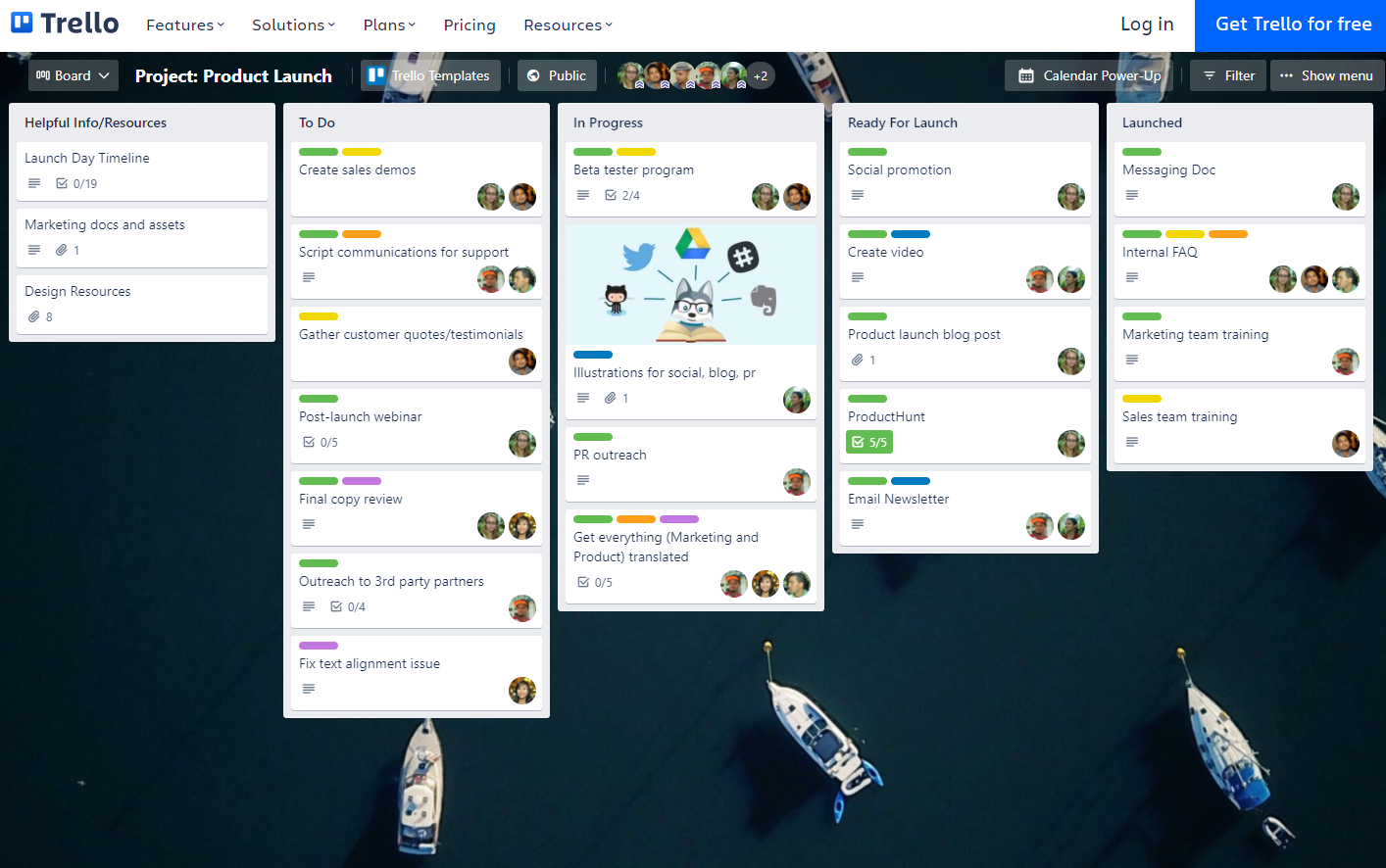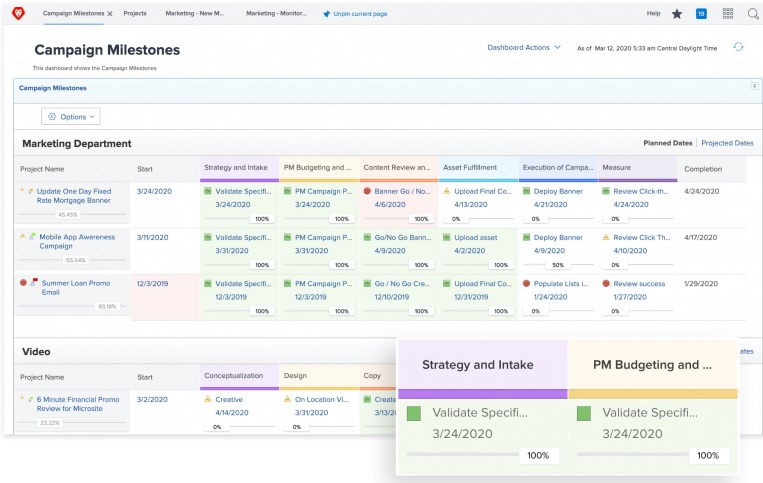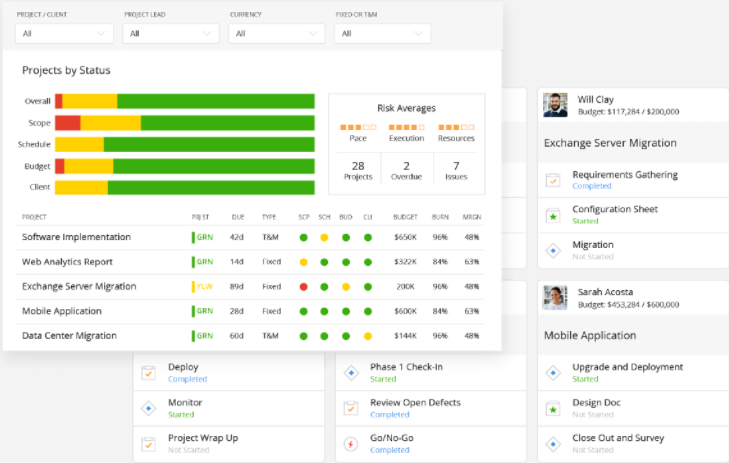
I’m a very organized person. I love staying on top of my tasks and projects, and I’m fortunate that I found my passion for project management very early in my career. As a result, I’ve had the opportunity to work with several different project management tools and experience the pros and cons of each.
Choosing the best project management tool for your line of business is essential if you want to stay on top of your goals and objectives. Whether you need it to assign tasks, collaborate with other team members, or manage a project in its entirety, project management software boosts efficiency across all stages of a project. For a good overview, one of my colleagues did a great job sharing some of the most common features available in the top project management tools.
Most modern project management tools offer secure, scalable, user-driven, and collaborative environments. However, they all have unique feature and benefits that set them apart. Below, I’ve included my top five picks — in no order — based on my experience with the hope it will help others determine the best tool for their needs.
1. Asana

Image Source: Asana
Asana is “a web and mobile work management platform designed to help teams organize, track, and manage their work.” One of my current clients uses Asana, and I’ve worked with it for about six months. While I haven’t used it in a full project management capacity, I do use it to allocate resources and oversee tasks, and I find it to be very intuitive. With a clean and visually appealing interface, it makes for a very user-friendly tool that team members from any level can operate.
Key Features:
- See project progress and track individual tasks.
- Visualize your work however you like with board, list, timeline, and calendar views.
- Resources and templates available for sprint planning projects
- Integrates with several tools, including Microsoft Outlook, Gmail, Google Drive, OneLogin, Zapier, and more.
Key Benefits:
- Get projects up and running more quickly.
- Keep all internal and external project-related communications, plans, and files in one place.
- Make it easy to meet deadlines with easy access, visibility, and push notifications.
- Prioritize tasks so everyone knows what’s most important.
- Know what’s going on at any given moment with real-time status updates and built-in reporting.
- Basic: For individuals or teams just getting started with project management (free)
- Premium: For teams that need to create project plans with confidence ($10.99/mo)
- Business: For teams and companies that need to manage work across initiatives ($24.99/mo)
- Enterprise: For organizations that need centralized visibility, control, and support with advanced admin features and security (contact Asana for pricing)
2. Trello

Image Source: Trello
Trello is one of my favorite project management tools. In addition to using it professionally, I also use it to manage personal projects, family events, and travel. In fact, I’m using Trello to plan all of the festivities — from booking the venue and finding a photographer to ordering the food and managing the budget — for my sweet nephew’s first birthday this summer. Trello is different from other project management tools because it uses the Kanban project management philosophy.
Key Features:
- Provides high-level project visibility with a Kanban view and management system.
- Take advantage of timeline, workspace table, calendar, and map views.
- Quickly move cards around with drag-and-drop functionality.
- Integrates with Slack, Dropbox, Google Drive, Confluence, Evernote, and more.
- Available on iOS and Android mobile apps.
Key Benefits:
- Get up and running quickly with intuitive, easy-to-use features.
- Save time by minimizing tedious tasks with built-in automation.
- Experience a visually appealing interface where you can color-code labels and include pictures.
- Free: For individuals or teams looking to organize anything
- Standard: For teams that need to manage more work and scale collaboration ($5/mo)
- Premium: Best for teams up to 100 that need to track multiple projects and visualize work in a variety of ways ($10/mo but can try for free)
- Enterprise: For organizations that need to connect work across teams with more security and controls ($17.50/mo)
3. Workfront

Image Source: Workfront
Adobe Workfront declares itself as work management built for the enterprise where you can connect, collaborate, and execute on complex workflows — from anywhere. Workfront is my second favorite project management tool. I’m currently using it to manage a complex client initiative with several mini-projects rolled up into it. I mainly use it to assign resources to tasks, make comments and provide feedback, and track progress. Workfront is better suited to complex projects and initiatives that involve multiple stakeholders.
Key Features:
- Assign resources to tasks and track progress.
- Auto-route certain tasks based on custom logic.
- Work smarter with built-in dashboards, unlimited reporting, and enhanced analytics.
- Integrates with top enterprise tools and systems, including Adobe Creative Cloud, Outlook, Salesforce, Zoom, Slack, Jira, Box, Google Drive, SharePoint, and more.
- Available on iOS and Android mobile apps.
Key Benefits:
- Save time by choosing from a variety of project templates.
- Simplify resource management with AI-enabled team, project, and global resource scheduling.
- Drive better collaborative work management through integration with Adobe.
Pricing Plans (no cost information publicly available):
- Pro: Resource management, demand management, and content review/approval within a single department
- Business: Includes premium integrations, unlimited reviews, and enhanced analytics for cross-functional collaboration across multiple departments
- Enterprise: Includes premium APIs and integrations, enhanced security, and advanced support across the enterprise
4. Mavenlink

Image Source: Mavenlink
With a wide range of functions, Mavenlink provides a practical way to organize operational management processes. I’ve used Mavenlink for over two years and it’s one of my favorite Project Management tools out on the market because it has a clever way of simplifying complex projects by use of the Gannt Chart (a big selling point for project managers). Gantt charts provide a holistic view of your project from start to finish and allow for efficient planning and frictionless team collaboration.
Key Features:
- Get a quick snapshot of your project’s progress with timeline view.
- Match high-impact employees with high-priority projects with ease.
- Integrates with Salesforce, Google Workspace, Jira, Workday, HubSpot, Qualtrics and more
Key Benefits:
- Optimize resource planning.
- Simplify estimating and improve forecasting.
- Manage to budget with real-time tracking of working hours and expenses.
- Plans start at $19 per user per month with 3 other pricing tiers available (varies by industry, company size, etc.)
5. Smartsheet

Image Source: Smartsheet
As a Campaign Manager, I use Smartsheet to allocate resources to tasks and manage client requests. In addition to monitoring progress at a granular level, I can quickly see what percentage of a task or client request that’s been completed. I can communicate and collaborate with clients directly in Smartsheet as well as easily create engagement dashboards that visually demonstrate the level of progress and budget consumption. If you work with clients, Smartsheet is great because you can also use it to manage financial aspects of the project and invoicing.
Key Features:
- Integrates seamlessly with your existing tech stack
- Intuitive, familiar spreadsheet visual format
- Provides high-level overviews with custom dashboards
Key Benefits:
- Tailored reporting that pulls data from multiple sources within various sheets
- Robust workflow automation tools
- Easy customization for client and project needs
- Pro: Teams can collaborate, track, manage, and execute their work in real-time, all in one place ($7/user/mo)
- Business: Provide your teams with improved project, program, and process management, with unlimited automated workflows ($25/user/mo)
- Enterprise: Manage work across your enterprise with a powerful no-code app builder and enhanced IT governance and administration (contact Smartsheet for pricing)
Plan any project, big or small
Remote work has skyrocketed over the past couple of years, and it looks like it just may be here to stay. While working remotely provides a number of benefits, for both employees and their employers, it does make choosing the right project management tool for your business that much more important. Because even though you can’t all get together in the same conference room, you can have one place to go for everyone involved in making your projects successful.

As a Demand Generation Campaign Manager, Alyssa Crowe is responsible for the performance, delivery, and operation of BDO Digital’s Campaign Execution Services. Before joining the team, Alyssa served as a Lead Project Manager for Investis Digital, where she played an integral part in rebranding web campaigns and developing digital marketing strategies across a global landscape. Her knowledge of campaign management best practices and procedures — along with establishing streamlined processes, documenting critical needs from the client, and identifying potential risks associated with current or ongoing projects — makes her a distinct player in BDO Digital’s Demand Generation Group.
The post 5 of the Best Project Management Software and Tools in 2022 appeared first on DemandGen.























